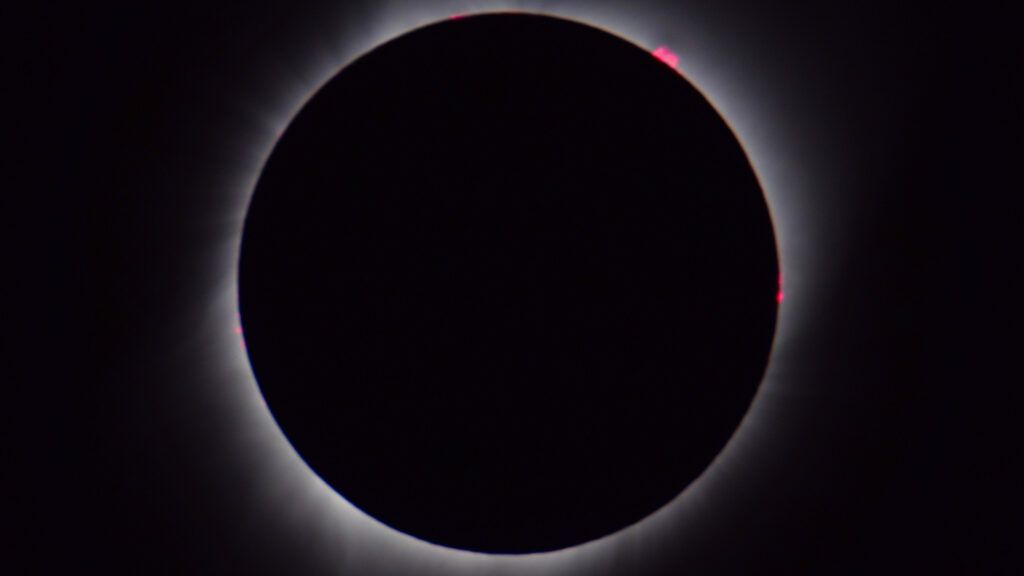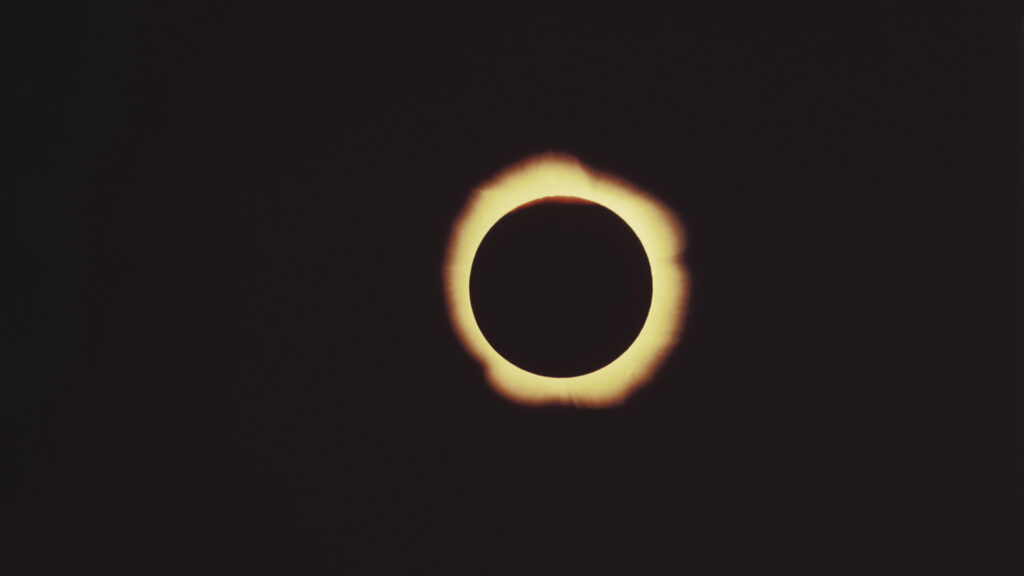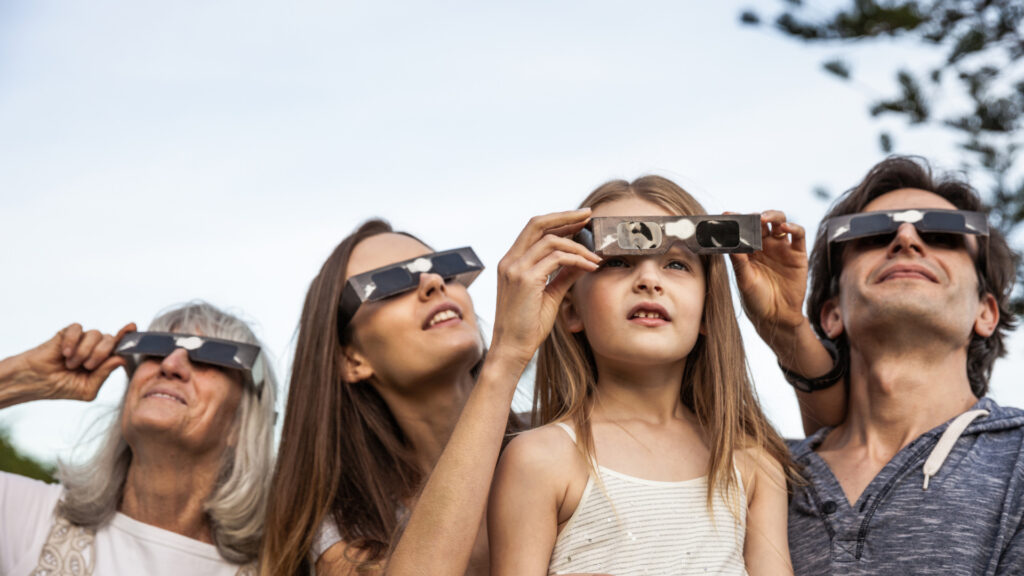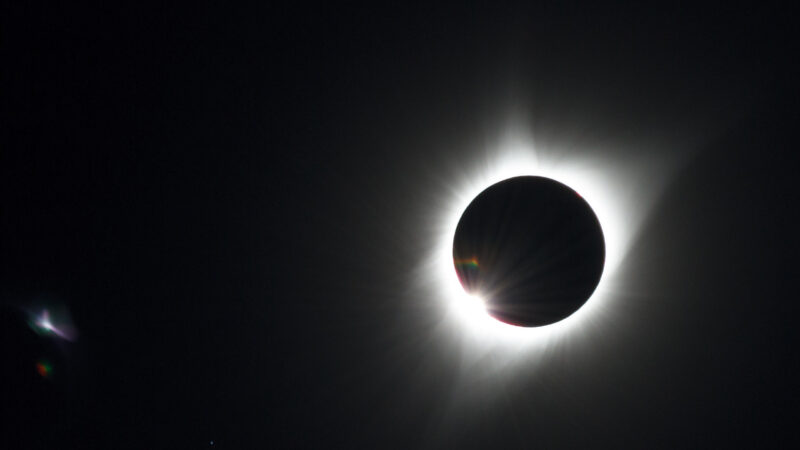Table of Contents Show
Did you know we’ll experience a solar eclipse in 2024? Perhaps you were in the path of totality for the Great American Eclipse in 2017. It spanned from the Pacific coast to the Atlantic coast and included 14 states. But even if you weren’t along this path, you likely experienced a partial eclipse since it was visible anywhere in the contiguous United States.
But the solar eclipse 2024 already has scientists and potential observers talking and planning to be in the path of totality from Texas to Maine.
Let’s learn more so you can mark your calendars to witness this natural phenomenon!
What Is a Solar Eclipse?
Solar eclipses aren’t a once-in-a-lifetime occurrence, but they’re rare enough that we make a spectacle when one happens.
This natural phenomenon happens when the moon passes between the sun and Earth, completely blocking the sun’s view for a few minutes. The sky darkens like at dawn or dusk, and then as the sun begins peaking through again, complete daylight returns.

When Was the Last Total Solar Eclipse in the U.S.?
The last total solar eclipse in the United States happened on August 21, 2017. According to the American Astronomical Society, it “was the first to touch the ‘Lower 48’ since 1979 and the first to span the U.S. from coast to coast since 1918.”
However, that doesn’t mean this was the last total solar eclipse seen on Earth. Antarctica witnessed a total solar eclipse on December 4, 2021.
How Often Do Total Solar Eclipses Happen?
Primitive cultures often thought disaster or punishment from the gods would befall them during a solar eclipse. In many of these cultures, the sun and moon were (and still are) viewed as deities. So to have the sun disappear entirely from view would have been terrifying.
Thankfully for them, solar eclipses didn’t happen often. There is a solar eclipse about every 18 months, but this natural phenomenon isn’t seen everywhere on Earth.
These indigenous people probably only saw one solar eclipse in their lifetime.
Statistically, one location on the earth will only see a solar eclipse once every 375 years or so. But it’s still possible for certain areas to have more sightings and others to have fewer.
For example, Atlanta, Ga., saw a solar eclipse on June 24, 1778, but the next occurrence isn’t predicted to happen until May 11, 2078. However, some people from Angola experienced a total solar eclipse north of Lobito on June 21, 2001, and another on Dec. 4, 2002.

What Are the Stages of a Total Solar Eclipse?
To view all of the stages of the total solar eclipse in 2024, you must be along the path of totality. You’ll only witness a partial solar eclipse if you’re just slightly outside the track.
But if you’re lucky enough to be in the path of totality, you’ll first see the moon passing between the sun and Earth. It creates a partial eclipse for about 70-80 minutes, and the sun appears to have a crescent shape.
Then as the moon continues to move across the sun, you’ll see shadow bands appear. You can see these rapidly moving, long, dark bands on the sides of buildings or the ground.
It’s very difficult to photograph these faint shadows, but you can notice them as the earth’s atmosphere distorts the light from the sun.
Next, Baily’s Beads appear. These light rays stream through the valleys along the moon’s horizon, and not everyone can see them.
What’s called the “Diamond Ring” occurs next. A single bright spot remains along the top edge of the moon’s shadow and resembles a diamond.
When the diamond ring disappears, totality has arrived. It’s safe to take off glasses at this point and look directly at the total solar eclipse. You’ll see a red ring from the sun’s corona around the moon.
This time period may only last a few minutes, and you should put your glasses back on before totality ends. As the moon moves past the sun, the stages will cycle backward from the diamond ring to Baily’s Beads to shadow bands. And then, the entire sun will return to full view.
When Is the Solar Eclipse in 2024?
Solar eclipse 2024 will occur in North America on April 8. Only observers in Mexico, the United States, and Canada, will have a chance to view this natural phenomenon.
If you want to view it, you might plan to take off work that Monday. The next total solar eclipse won’t happen until August 12, 2026, but you won’t see it unless you’re in Spain, Iceland, Greenland, or northeastern Portugal.
Keep in Mind: Is Alaska Closer to Russia or America? Click the link to find out!
Where Will the Total Solar Eclipse 2024 Be Seen?
To see the total solar eclipse of 2024, you have to be in the path of totality. NASA explains that the total solar eclipse will begin over the South Pacific Ocean. Mexico’s Pacific coast will be the first to witness the phenomenon around 11:07 a.m.
Then the path continues into Texas, including the cities of San Antonio, Austin, and Dallas.
Observers in parts of Oklahoma, Arkansas, Missouri, Illinois, Kentucky, Indiana, Ohio, Pennsylvania, New York, Vermont, New Hampshire, and Maine will be along the path of totality.
Little Rock, Indianapolis, Cleveland, Buffalo, Rochester, and Burlington are all situated perfectly to view the solar eclipse 2024.
How to Protect Your Eyes During the Solar Eclipse 2024
Viewing any solar eclipse is dangerous without the proper eyewear. To enjoy the total solar eclipse 2024, you must look through special solar viewing glasses called “eclipse glasses” or through a safe handheld solar viewer at all times.
Regular sunglasses will not work. You can buy your safe viewing glasses or handheld solar viewers at Space.com from reputable vendors. You can severely damage your eyes if you ignore warnings.
NASA also warns against looking through a camera lens, telescope, or binoculars, even while wearing eclipse glasses or using a handheld solar viewer.
“The concentrated solar rays will burn through the filter and cause serious eye injury.” You have to purchase a proper solar filter to use with these tools.
If you can’t get ahold of eclipse glasses or don’t want to pay for a pair, you can still witness the total solar eclipse 2024 through an indirect viewing method. Use a pinhole projector with a small opening like a hole-punched index card and project the sun onto a nearby surface.
This method puts the sun at your back so you can view the projected image, but ensure you don’t look through the pinhole.
When totality arrives, it’s safe to take off your eclipse glasses or turn around if using an indirect viewing method and look directly at the sun.
Because the moon will completely obscure it, you can safely see it with the naked eye. But as soon as any light reappears, it’s critical to cover your eyes again.
Keep in Mind: Other than Air Force One, there might not be another vehicle with as much history as the NASA Astrovan

Don’t Miss It – The Solar Eclipse 2024 Is Coming!
Space.com explains that total solar eclipses won’t last forever. According to data and research, “The moon is slowly moving away from Earth by about 1-1/2 inches (4 centimeters) per year…As a result, total solar eclipses will cease to exist in the very distant future because the apparent size of the moon in Earth’s sky will be too small to cover the sun completely.”
Now “very distant future” means about 600 million years from now, so those living in the 21st Century don’t need to fear missing out as long as we can catch the total solar eclipse of 2024.
Will you plan a special trip to be somewhere in the track between Texas and Maine in April 2024?






